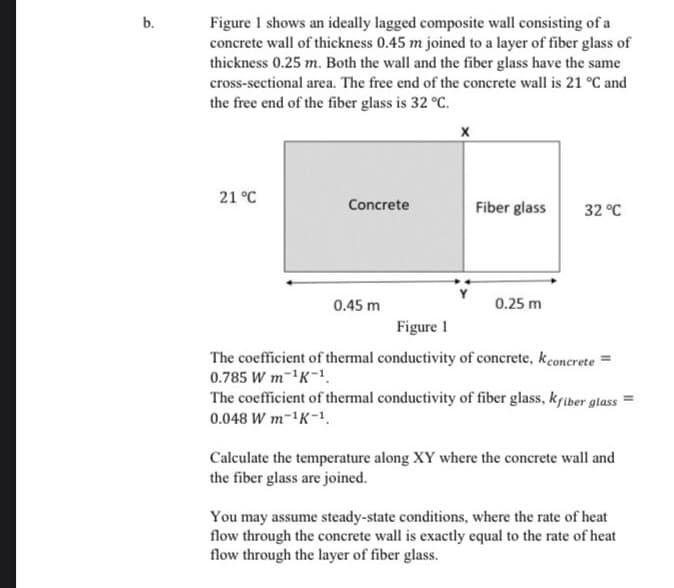Figure 1 shows an ideally lagged composite wall consisting of a concrete wall of thickness 0.45 m joined to a layer of fiber glass of thickness 0.25 m. Both the wall and the fiber glass have the same b. cross-sectional area. The free end of the concrete wall is 21 °C and the free end of the fiber glass is 32 °C. 21 °C Concrete Fiber glass 32 °C 0.45 m 0.25 m Figure 1 The coefficient of thermal conductivity of concrete, kconcrete 0.785 W m-K-1. The coefficient of thermal conductivity of fiber glass, kriber glass 0.048 W m-'K-1. Calculate the temperature along XY where the concrete wall and the fiber glass are joined. You may assume steady-state conditions, where the rate of heat flow through the concrete wall is exactly equal to the rate of heat flow through the layer of fiber glass.
Figure 1 shows an ideally lagged composite wall consisting of a concrete wall of thickness 0.45 m joined to a layer of fiber glass of thickness 0.25 m. Both the wall and the fiber glass have the same b. cross-sectional area. The free end of the concrete wall is 21 °C and the free end of the fiber glass is 32 °C. 21 °C Concrete Fiber glass 32 °C 0.45 m 0.25 m Figure 1 The coefficient of thermal conductivity of concrete, kconcrete 0.785 W m-K-1. The coefficient of thermal conductivity of fiber glass, kriber glass 0.048 W m-'K-1. Calculate the temperature along XY where the concrete wall and the fiber glass are joined. You may assume steady-state conditions, where the rate of heat flow through the concrete wall is exactly equal to the rate of heat flow through the layer of fiber glass.
Principles of Heat Transfer (Activate Learning with these NEW titles from Engineering!)
8th Edition
ISBN:9781305387102
Author:Kreith, Frank; Manglik, Raj M.
Publisher:Kreith, Frank; Manglik, Raj M.
Chapter1: Basic Modes Of Heat Transfer
Section: Chapter Questions
Problem 1.3P: 1.3 A furnace wall is to be constructed of brick having standard dimensions of Two kinds of...
Related questions
Question

Transcribed Image Text:b.
Figure 1 shows an ideally lagged composite wall consisting of a
concrete wall of thickness 0.45 m joined to a layer of fiber glass of
thickness 0.25 m. Both the wall and the fiber glass have the same
cross-sectional area. The free end of the concrete wall is 21 °C and
the free end of the fiber glass is 32 °C.
21 °C
Concrete
Fiber glass
32 °C
0.45 m
0.25 m
Figure 1
The coefficient of thermal conductivity of concrete, kconcrete
0.785 W m-'K-1.
The coefficient of thermal conductivity of fiber glass, kriber glass =
0.048 W m-1K-1.
Calculate the temperature along XY where the concrete wall and
the fiber glass are joined.
You may assume steady-state conditions, where the rate of heat
flow through the concrete wall is exactly equal to the rate of heat
flow through the layer of fiber glass.
Expert Solution
This question has been solved!
Explore an expertly crafted, step-by-step solution for a thorough understanding of key concepts.
Step by step
Solved in 2 steps with 1 images

Knowledge Booster
Learn more about
Need a deep-dive on the concept behind this application? Look no further. Learn more about this topic, mechanical-engineering and related others by exploring similar questions and additional content below.Recommended textbooks for you

Principles of Heat Transfer (Activate Learning wi…
Mechanical Engineering
ISBN:
9781305387102
Author:
Kreith, Frank; Manglik, Raj M.
Publisher:
Cengage Learning

Principles of Heat Transfer (Activate Learning wi…
Mechanical Engineering
ISBN:
9781305387102
Author:
Kreith, Frank; Manglik, Raj M.
Publisher:
Cengage Learning